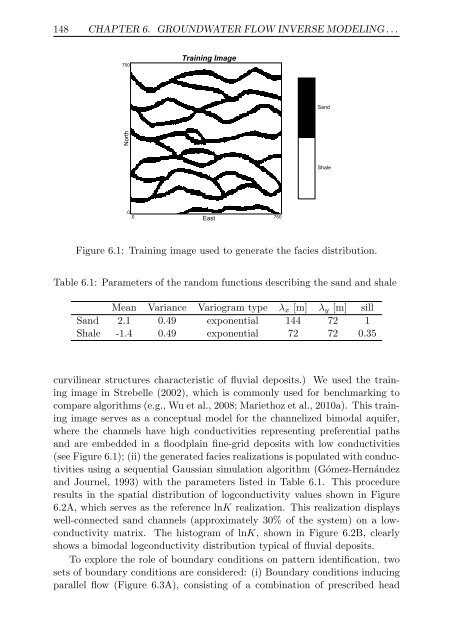Upscaling and Inverse Modeling of Groundwater Flow and Mass ...
Upscaling and Inverse Modeling of Groundwater Flow and Mass ...
Upscaling and Inverse Modeling of Groundwater Flow and Mass ...
Create successful ePaper yourself
Turn your PDF publications into a flip-book with our unique Google optimized e-Paper software.
148 CHAPTER 6. GROUNDWATER FLOW INVERSE MODELING . . .<br />
750<br />
North<br />
Training Image<br />
.0<br />
.0 East<br />
750<br />
Figure 6.1: Training image used to generate the facies distribution.<br />
Table 6.1: Parameters <strong>of</strong> the r<strong>and</strong>om functions describing the s<strong>and</strong> <strong>and</strong> shale<br />
Mean Variance Variogram type λx [m] λy [m] sill<br />
S<strong>and</strong> 2.1 0.49 exponential 144 72 1<br />
Shale -1.4 0.49 exponential 72 72 0.35<br />
curvilinear structures characteristic <strong>of</strong> fluvial deposits.) We used the training<br />
image in Strebelle (2002), which is commonly used for benchmarking to<br />
compare algorithms (e.g., Wu et al., 2008; Mariethoz et al., 2010a). This training<br />
image serves as a conceptual model for the channelized bimodal aquifer,<br />
where the channels have high conductivities representing preferential paths<br />
<strong>and</strong> are embedded in a floodplain fine-grid deposits with low conductivities<br />
(see Figure 6.1); (ii) the generated facies realizations is populated with conductivities<br />
using a sequential Gaussian simulation algorithm (Gómez-Hernández<br />
<strong>and</strong> Journel, 1993) with the parameters listed in Table 6.1. This procedure<br />
results in the spatial distribution <strong>of</strong> logconductivity values shown in Figure<br />
6.2A, which serves as the reference lnK realization. This realization displays<br />
well-connected s<strong>and</strong> channels (approximately 30% <strong>of</strong> the system) on a lowconductivity<br />
matrix. The histogram <strong>of</strong> lnK, shown in Figure 6.2B, clearly<br />
shows a bimodal logconductivity distribution typical <strong>of</strong> fluvial deposits.<br />
To explore the role <strong>of</strong> boundary conditions on pattern identification, two<br />
sets <strong>of</strong> boundary conditions are considered: (i) Boundary conditions inducing<br />
parallel flow (Figure 6.3A), consisting <strong>of</strong> a combination <strong>of</strong> prescribed head<br />
S<strong>and</strong><br />
Shale


